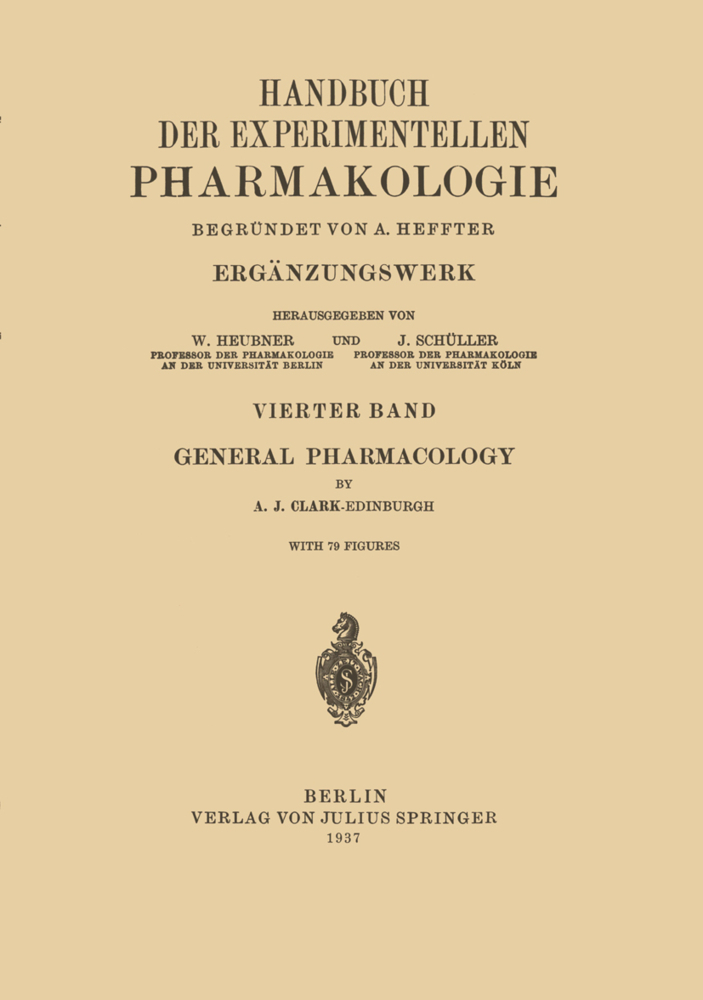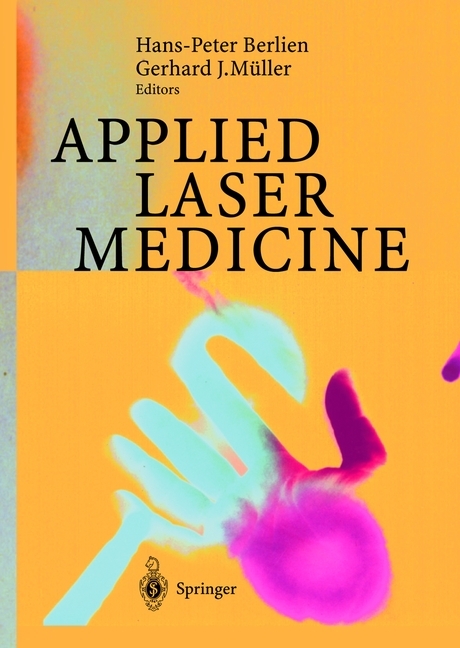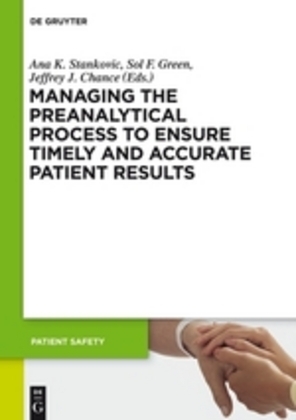General Pharmacology
General Pharmacology
The author's general aim has been to survey as wide a field of evidence as possible and this had involved excursions into subjects of which he has little first hand knowledge. This width of range also has necessitated a somewhat arbitrary selection of evidence and has prevented full discussion of any indi vidual problem. The author trusts that he has not misrepresented anyone's results or opinions, and if this has occurred, he can only plead in excuse the peculiar difficulty of giving a brief and yet accurate account of evidence of such a wide variety. The diagrams reproduced in the article have all been redrawn and in many cases the original figures or diagrams have been modified as, for instance, by recalculating dosage on the logarithmic scale. The original authors therefore have no direct responsibility for the diagrams in their present form. The author desires to thank Messrs Arnold and Co. for permitting the repro duction of Figs. 9 and 23 from similar figures which appeared in his book "The Mode of Action of Drugs on Cells"; portions of other figures from this book also have been reproduced in modified form. The author also desires to thank Dr. J. M. ROBSON for help in correction of the proofs. Edinburgh, July, 1937. A. J. CLARK. Contents.
Selection of Material
Employment of Physicochemical Methods
The Mathematical Interpretation of Biological Data
Favourable Factors in Pharmacological Measurements
Curves Relating Exposure to Drugs with Biological Effect
Classes of Curves
Discussion
2: The Cell as a Physicochemical System
The Structure of Protoplasm
The Cell Surface
Cell Permeability
Structure of Plasmatic Membrane
Cell Organisation
3: General Characteristics of the Cell-Drug System
Dimensions of Molecules and Cells
The Number of Molecules in Single Cells
The Number of Enzyme Molecules per Cell
Lethal Doses of Drugs per Cell
Effective Doses of Drugs per Cell
Minimum Active Doses of Drugs per Organism
Minimum Active Dilutions of Drugs
Intracellular Administration of Drugs
Types of Action of Drugs on Cells
Discussion
4: Reactions between Drugs and Active Proteins
Symplex Compounds
Combination of Haemoglobin with Oxygen and Carbon Monoxide
Antagonism of Oxygen and Carbon Monoxide
Discussion
5: The Action of Drugs on Catalysts and Enzymes
Poisoning of Inorganic Catalysts
General Characters of Enzymes
Enzyme Activity
General Characters of the Poisoning of Enzymes
Diphasic Actions of Enzyme Poisons
The Rate of Action of Enzyme Poisons
Relation between Concentration of Poison and Inhibition of Enzyme
Discussion
6: Action of Heavy Metals on Enzymes in vitro and in vivo
Action of Heavy Metals on Saccharase
Concentration-action Relations of Heavy Metals and Enzymes
The Action of Metals on Living Cells
Relation between Metal Concentration and Action on Cells
Minimum Lethal Concentrations of Heavy Metals
Relative Toxicity of Metals
Course of Reaction between Metals and Cells
Diphasic Actions of Metals on Cells
Discussion
7: Action of Various Enzyme Poisons in vitro and in vivo
The Action of Dyes on Enzymes
Action of Quinine on Enzymes
Action of Quinine on Cells
Action of Cyanide on Enzymes and Cells
Diphasic Actions of Cyanide
Phenol Compounds
The Action of Narcotics
Action of Narcotics on Enzymes
Action of Narcotics on Cells
Theories of Narcotic Action
Discussion
8: Concentration-action Relations I
(1) Classification of Concentration-action Curves
Relations Depending on Mass-action p.
All-or-None Effects p.
(2) Concentration-action Relations Attributable to Mass-action Laws
The Mode of Action of Acetylcholine p.
Amount of Aeetylcholine Acting on Cells p.
Individual Variation p.
Site of Action of Acetylcholine p.
Influence of Temperature on Acetylcholine Response p.
Specificity of Aeetyleholine Action p.
Possible Nature of Acetylcholine Receptors p.
Acetylcholine Esterase p.
Concentration-action Relations of Adrenaline p.
Dosage of Adrenaline p.
Concentration-action Relations Found with Various Hormones p.
Insulin p.
Thyroxin p.
Posterior Pituitary Principles p.
Sex Hormones p.
Various Alkaloids p.
Nicotine p.
Physostigmine p.
Other Alkaloids p.
9: Concentration-action Relations II
(3) Linear Relations; Action of Narcotics
(4) All-or-None Responses
Instrumental Errors p.
Distortion by the Cell of some Chemical Relation p.
Obligatory All-or-None effects p.
All-or-None Cellular Responses p.
Concentration-action Curves with Guinea Pig's Uterus p.
Drugs Producing All-or-None Effects p.
Discussion p.
10: Quantitative Pharmacology and the Theory of Humoral Transmission
Quantitative Data
Rate of Action
Concentration-action Relations.-Specific Antagonisms
Discussion
11: Kinetics of Drug Action
Sources of Error in Kinetic Measurements
(1) Kinetics of Reactions in Heterogenous Systems
(2) Kinetics of Cell Reaction
Delays in Drug Action Due to Diffusion to Cell Surface p.
Penetration of Cells p.
Delay in Biological Response p.
(3) Maximum Rate of Drug Action
12: The Rate of Action of Drugs on Cells
(1) Curves Relating Time and Graded Action
The Shapes of Time-action Curves p.
(2) Curves Relating Time and All-or-None Effects
Kinetics of Protein Precipitation p.
Precipitation of Protein by Phenol p.
(3) Time Action Curves as Expressions of Variation
Calculation of Time-action Curves p.
Time Relations of Toxic Action of Copper on Algae p.
(4) Implications of Monomolecular Theory
Quantitative Measurements of Drug Uptake p.
Drug Actions as Chain Processes p.
(5) Mortality Curves
(6) Action of Radiations
Discussion p.
13: Time-concentrations Curves
(1) Form of Curves and Possible Significance
(2) Time-concentration Curves of Nerve Paralysis
(3) Time-concentration Curves with Various Drugs
(4) Time-concentration Relations in Disinfection
(5) Toxic Vapours
Deviation of Narcotics p.
Time-concentration Curves of Anaesthetics p.
Time-concentration Curves of Hydrocyanic Acid p.
Irritant Gases p.
Discussion p.
14: Individual Variation of Response to Drugs
Methods of Measurement of Individual Variation
Skew Variation in Biological Material
Normal Equivalent Deviation
Errors in Construction of Characteristic Curves
Uniformity of Population
Errors of Sampling
15: Relation between Various Types of Curves Expressing Response of Cells to Drugs
(1) Concentration-action Curves as Expressions of Individual Variation
Virus Infections p.
Discussion p.
(2) Characteristic Curves as Expressions of Chemical Processes
(3) Correlation between Concentration-action Curves and Characteristic Curves
Examples of Skewed Characteristic Curves p.
All-or-None Effects p.
Discussion p.
(4) Drug Responses and Individual Variation
16: Special Problems Relating to Variation of Populations
Uniformity of Population
Influence of Sex, Age and Weight on Response to Drugs
Seasonal Variations in Sensitivity
Variation in Human Populations
Hypersensitivity and Idiosyncrasy
Margin of Safety with Massive Doses
Disinfection, etc.
17: Quantitative Aspects of Drug Antagonism and of Drug Synergism
The antagonism of cyanides by narcotics
Selective Antagonisms with Haemoglobin
Antagonism in Enzyme Poisoning
Acetyl Choline-Atropine Antagonism
Adrenaline-Ergotoxine Antagonism
Synergists of Adrenaline
Comparison of Antagonisms found with Enzymes and with Hormones
18: Qualitative Aspects of Drug Antagonism
Antagonism of Adrenaline
Chemical Structure of Acetyl Choline Antagonists
Acetyl Choline Antagonism in Different Tissues
Analysis of Drug Actions by Drug Antagonisms
General Theory of Drug Antagonisms
19: Alternative Theories of Drug Action
Monomolecular Theory
The Potential Theory of Drug Action
Phasic response of cells
Arndt-Schulz Law
Drug Responses as Expression of Individual Variation
Weber-Fechner Law
Discussion
20: Quantitative Aspects of Chemotherapy
Action of Metallic Compounds
Action of Non-metallic Compounds
Drug-resistance
Discussion
21: Conclusion
Index of Authors
Index of Subjects.
1: Methods of General Pharmacology
General ConsiderationsSelection of Material
Employment of Physicochemical Methods
The Mathematical Interpretation of Biological Data
Favourable Factors in Pharmacological Measurements
Curves Relating Exposure to Drugs with Biological Effect
Classes of Curves
Discussion
2: The Cell as a Physicochemical System
The Structure of Protoplasm
The Cell Surface
Cell Permeability
Structure of Plasmatic Membrane
Cell Organisation
3: General Characteristics of the Cell-Drug System
Dimensions of Molecules and Cells
The Number of Molecules in Single Cells
The Number of Enzyme Molecules per Cell
Lethal Doses of Drugs per Cell
Effective Doses of Drugs per Cell
Minimum Active Doses of Drugs per Organism
Minimum Active Dilutions of Drugs
Intracellular Administration of Drugs
Types of Action of Drugs on Cells
Discussion
4: Reactions between Drugs and Active Proteins
Symplex Compounds
Combination of Haemoglobin with Oxygen and Carbon Monoxide
Antagonism of Oxygen and Carbon Monoxide
Discussion
5: The Action of Drugs on Catalysts and Enzymes
Poisoning of Inorganic Catalysts
General Characters of Enzymes
Enzyme Activity
General Characters of the Poisoning of Enzymes
Diphasic Actions of Enzyme Poisons
The Rate of Action of Enzyme Poisons
Relation between Concentration of Poison and Inhibition of Enzyme
Discussion
6: Action of Heavy Metals on Enzymes in vitro and in vivo
Action of Heavy Metals on Saccharase
Concentration-action Relations of Heavy Metals and Enzymes
The Action of Metals on Living Cells
Relation between Metal Concentration and Action on Cells
Minimum Lethal Concentrations of Heavy Metals
Relative Toxicity of Metals
Course of Reaction between Metals and Cells
Diphasic Actions of Metals on Cells
Discussion
7: Action of Various Enzyme Poisons in vitro and in vivo
The Action of Dyes on Enzymes
Action of Quinine on Enzymes
Action of Quinine on Cells
Action of Cyanide on Enzymes and Cells
Diphasic Actions of Cyanide
Phenol Compounds
The Action of Narcotics
Action of Narcotics on Enzymes
Action of Narcotics on Cells
Theories of Narcotic Action
Discussion
8: Concentration-action Relations I
(1) Classification of Concentration-action Curves
Relations Depending on Mass-action p.
All-or-None Effects p.
(2) Concentration-action Relations Attributable to Mass-action Laws
The Mode of Action of Acetylcholine p.
Amount of Aeetylcholine Acting on Cells p.
Individual Variation p.
Site of Action of Acetylcholine p.
Influence of Temperature on Acetylcholine Response p.
Specificity of Aeetyleholine Action p.
Possible Nature of Acetylcholine Receptors p.
Acetylcholine Esterase p.
Concentration-action Relations of Adrenaline p.
Dosage of Adrenaline p.
Concentration-action Relations Found with Various Hormones p.
Insulin p.
Thyroxin p.
Posterior Pituitary Principles p.
Sex Hormones p.
Various Alkaloids p.
Nicotine p.
Physostigmine p.
Other Alkaloids p.
9: Concentration-action Relations II
(3) Linear Relations; Action of Narcotics
(4) All-or-None Responses
Instrumental Errors p.
Distortion by the Cell of some Chemical Relation p.
Obligatory All-or-None effects p.
All-or-None Cellular Responses p.
Concentration-action Curves with Guinea Pig's Uterus p.
Drugs Producing All-or-None Effects p.
Discussion p.
10: Quantitative Pharmacology and the Theory of Humoral Transmission
Quantitative Data
Rate of Action
Concentration-action Relations.-Specific Antagonisms
Discussion
11: Kinetics of Drug Action
Sources of Error in Kinetic Measurements
(1) Kinetics of Reactions in Heterogenous Systems
(2) Kinetics of Cell Reaction
Delays in Drug Action Due to Diffusion to Cell Surface p.
Penetration of Cells p.
Delay in Biological Response p.
(3) Maximum Rate of Drug Action
12: The Rate of Action of Drugs on Cells
(1) Curves Relating Time and Graded Action
The Shapes of Time-action Curves p.
(2) Curves Relating Time and All-or-None Effects
Kinetics of Protein Precipitation p.
Precipitation of Protein by Phenol p.
(3) Time Action Curves as Expressions of Variation
Calculation of Time-action Curves p.
Time Relations of Toxic Action of Copper on Algae p.
(4) Implications of Monomolecular Theory
Quantitative Measurements of Drug Uptake p.
Drug Actions as Chain Processes p.
(5) Mortality Curves
(6) Action of Radiations
Discussion p.
13: Time-concentrations Curves
(1) Form of Curves and Possible Significance
(2) Time-concentration Curves of Nerve Paralysis
(3) Time-concentration Curves with Various Drugs
(4) Time-concentration Relations in Disinfection
(5) Toxic Vapours
Deviation of Narcotics p.
Time-concentration Curves of Anaesthetics p.
Time-concentration Curves of Hydrocyanic Acid p.
Irritant Gases p.
Discussion p.
14: Individual Variation of Response to Drugs
Methods of Measurement of Individual Variation
Skew Variation in Biological Material
Normal Equivalent Deviation
Errors in Construction of Characteristic Curves
Uniformity of Population
Errors of Sampling
15: Relation between Various Types of Curves Expressing Response of Cells to Drugs
(1) Concentration-action Curves as Expressions of Individual Variation
Virus Infections p.
Discussion p.
(2) Characteristic Curves as Expressions of Chemical Processes
(3) Correlation between Concentration-action Curves and Characteristic Curves
Examples of Skewed Characteristic Curves p.
All-or-None Effects p.
Discussion p.
(4) Drug Responses and Individual Variation
16: Special Problems Relating to Variation of Populations
Uniformity of Population
Influence of Sex, Age and Weight on Response to Drugs
Seasonal Variations in Sensitivity
Variation in Human Populations
Hypersensitivity and Idiosyncrasy
Margin of Safety with Massive Doses
Disinfection, etc.
17: Quantitative Aspects of Drug Antagonism and of Drug Synergism
The antagonism of cyanides by narcotics
Selective Antagonisms with Haemoglobin
Antagonism in Enzyme Poisoning
Acetyl Choline-Atropine Antagonism
Adrenaline-Ergotoxine Antagonism
Synergists of Adrenaline
Comparison of Antagonisms found with Enzymes and with Hormones
18: Qualitative Aspects of Drug Antagonism
Antagonism of Adrenaline
Chemical Structure of Acetyl Choline Antagonists
Acetyl Choline Antagonism in Different Tissues
Analysis of Drug Actions by Drug Antagonisms
General Theory of Drug Antagonisms
19: Alternative Theories of Drug Action
Monomolecular Theory
The Potential Theory of Drug Action
Phasic response of cells
Arndt-Schulz Law
Drug Responses as Expression of Individual Variation
Weber-Fechner Law
Discussion
20: Quantitative Aspects of Chemotherapy
Action of Metallic Compounds
Action of Non-metallic Compounds
Drug-resistance
Discussion
21: Conclusion
Index of Authors
Index of Subjects.
Clark, A. J.
| ISBN | 978-3-642-89607-1 |
|---|---|
| Artikelnummer | 9783642896071 |
| Medientyp | Buch |
| Auflage | Softcover reprint of the original 1st ed. 1937 |
| Copyrightjahr | 1937 |
| Verlag | Springer, Berlin |
| Umfang | VI, 230 Seiten |
| Abbildungen | VI, 230 p. 1 illus. |
| Sprache | Englisch |










